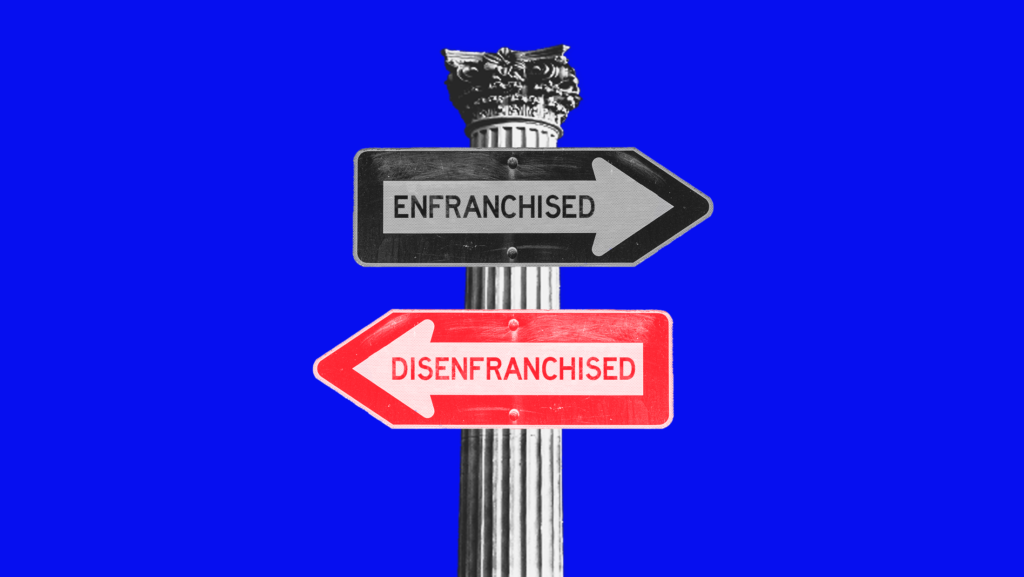State Lawmakers Must Step in to Remedy Supreme Court Voting Rights Blunder

This June, a 6-3 Supreme Court decision further eroded the Voting Rights Act (VRA) by upholding an Arizona law that disqualifies ballots cast by voters at any poll site other than the one assigned — an administrative technicality that has been shown to disproportionately impact minority communities in multiple states.
Sweeping new voting rights legislation introduced in Congress in September would prohibit this policy, as many states already do, which caused tens of thousands of registered voters to have their entire 2020 ballot suppressed merely because they were cast “out-of-precinct,” including their votes for contests all voters were eligible to participate in, like presidential, gubernatorial, congressional elections and more.
This punishing policy silenced nearly 40,000 voters in Arizona between 2008 and 2016, with voters of color impacted most severely. In the 2016 general election (the last general election prior to the lawsuit), Arizona’s “American Indians, Hispanics and African Americans voted [out-of-precinct] at twice the rate of whites.” The Supreme Court majority upheld the law, finding no violation of the Voting Rights Act.
Earlier this year, the nonpartisan VoteEarlyNY discovered that in the 2020 election, the ballots of nearly 14,000 registered New Yorkers were voided merely because they were cast at a different polling site from the one these voters were assigned.
At the heart of the Court’s decision is an ideological dispute about the expendability of fundamental rights, and what process is due before neutrally drafted technicalities can extinguish them.
The Court’s holding, couched in terms of the “usual burdens of voting”, green lights Arizona’s overbroad policy, and by extension, similar laws across the country that void entire ballots even when voters are misdirected, despite evidence that minority voters have their fundamental rights unequally nullified as a result — this is exactly what the VRA was intended to prevent.
Earlier this year, the nonpartisan VoteEarlyNY discovered that in the 2020 election, the ballots of nearly 14,000 registered New Yorkers were voided merely because they were cast at a different polling site from the one these voters were assigned. Of more than 9,000 votes disqualified in New York City, a disproportionate share (25%) came from majority-minority Bronx County where only 9% of the population identifies as non-Hispanic white. By comparison, Manhattan is 47% non-Hispanic white and has over 350,000 more registered voters, yet it accounted for only 17.2% of the disqualified out-of-precinct ballots.
In terms of scale, more registered voters had their ballots voided for this reason across New York than President Biden’s margin of victory in Georgia over Donald Trump. Soon after, Georgia’s GOP-controlled legislature passed new voting restrictions that will, among other things, disqualify more ballots from lost voters in the future.
The presidential horse race aside, the road to a 2022 House majority may actually run through New York for both parties. But in New York’s 22nd Congressional District — the last 2020 House race in the country to be decided — more ballots cast by registered voters entitled to vote in that contest were voided due to this overbroad rule than the final 109-vote victory certified in GOP Rep. Claudia Tenney’s favor over Democrat Anthony Brindisi.
Moreover, similar laws remain on the books in many states, including battlegrounds like Florida, Michigan, Ohio and Wisconsin. Like Arizona, in New York, the data demonstrated that this technical pitfall most impacts population-dense areas, with the 15 most densely populated counties in the state accounting for 94% of these disqualifications. Intuitively, that makes sense: a voter is more likely to unintentionally walk into a different poll site in a denser residential area that has multiple assigned sites placed close together than those residing in less densely populated communities.
Nationally, minority populations tend to be concentrated in dense metro areas where the impact of such a restriction is greater than in the more rural, whiter regions. And because voting is linked to residency, socio-economic markers like how often voters move, rates of homeownership and racial disparities found in poll site changes or consolidations likely magnify the impact. One study of New Orleans, for example, found that majority Black neighborhoods bore the brunt of polling place changes over several election cycles.
It is unclear what quantum of disproportionate racial impact may have persuaded the Supreme Court to rule differently in Arizona, where the scale of voters impacted has declined in recent years as alternatives like vote-by-mail and the shift to countywide “vote centers” (without single-site assignments) have grown in popularity. Although 3,709 out-of-precinct ballots were disqualified in Arizona in 2016, that was 10,000 ballots less than the 2020 figure for New York.
Lawmakers have options to protect voters from this overbroad penalty. Some states, like New Jersey, Maryland, New Mexico and Utah require the counting of any votes a voter would have been eligible to cast had they been redirected to their assigned poll site. Others (Washington and Colorado) mail every voter a ballot. In more populous areas of some states that otherwise disqualify out-of-precinct ballots, like Clark County in Nevada and Harris County in Texas, administrators deploy vote centers, circumventing the harm. California has embraced versions of all three in recent elections.
Without state-level action, however, thousands of registered voters will continue to be unknowingly disenfranchised. With federal legislation stymied by Jim Crow-era filibuster rules and courts deferring to state legislatures on questions fundamental to the character and legitimacy of our democracy, state policymakers must step in to remedy this unjust technicality.
Jarret Berg is a co-founder of VoteEarlyNY.
Rachel Landy is a voting rights advocate.